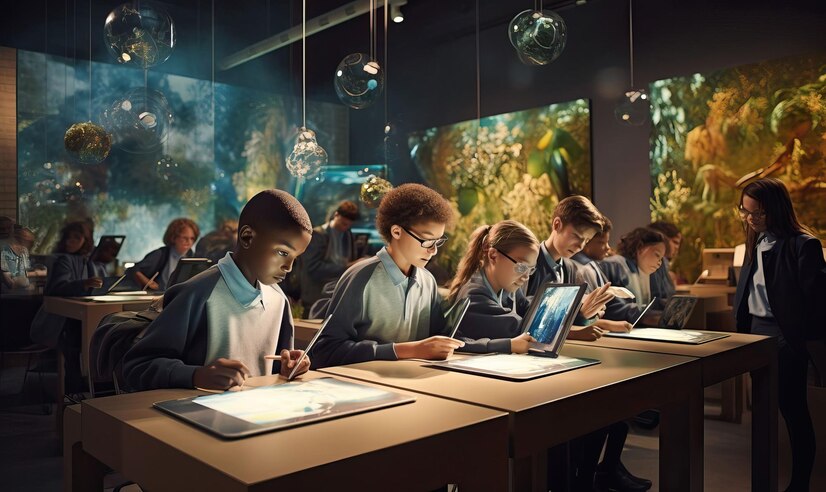Imagine stepping into a classroom where the walls are not just barriers but canvases for collaboration. Picture desks arranged to foster interaction, technology seamlessly integrated into every lesson, and students actively engaged in their learning journey. Welcome to Classroom 15x, a revolutionary approach that promises to redefine how we think about collaborative learning environments.
In today’s fast-paced world, traditional classrooms often fall short of meeting the diverse needs of learners. The rise of Classroom 15x challenges this norm by creating spaces that encourage teamwork, creativity, and engagement among students. By embracing innovative design and cutting-edge technology, these classrooms aim to prepare students for the complexities of modern life while making education an enjoyable experience.
Let’s dive deeper into what makes Classroom 15x stand out from conventional setups and explore its transformative effect on both educators and learners alike.
What Makes it Different from Traditional Classrooms?
Classroom 15x stands apart from traditional classrooms in several key ways. First, it emphasizes flexibility over rigidity. Students are no longer confined to rows of desks facing a single instructor.
The design fosters movement and interaction. Seating arrangements can be easily modified for group work or individual study, promoting spontaneous collaboration among peers.
Moreover, Classroom 15x integrates various learning styles seamlessly. Visual learners benefit from interactive displays while auditory learners engage through discussions in small clusters.
This environment encourages active participation rather than passive listening. In contrast to the lecture-based model of traditional classrooms, students take charge of their own learning experiences.
Technology plays a crucial role here—enhanced connectivity allows for real-time feedback and access to resources that enrich educational engagement beyond textbooks.
Benefits of Collaborative Learning Environments
Collaborative learning environments foster a sense of community among students. This unity encourages open communication and strengthens relationships, making learners feel more comfortable sharing ideas.
Students also benefit from diverse perspectives. Working together allows them to approach problems with various viewpoints, enhancing creativity and critical thinking skills. These interactions spark innovation that might not occur in isolation.
Moreover, collaborative settings promote accountability. When students depend on one another for success, they become more engaged and motivated to contribute actively.
Additionally, these environments prepare learners for real-world scenarios where teamwork is essential. Skills developed through collaboration are invaluable in today’s workforce, equipping students for future challenges.
The peer-to-peer support enhances learning retention. Students often grasp concepts better when they explain them to their classmates or hear different explanations from peers rather than solely relying on instructors.
How Classroom 15x Enhances Collaboration
Classroom 15x revolutionizes the learning experience by fostering a collaborative atmosphere. Its flexible design encourages students to engage with one another seamlessly.
With movable furniture, learners can quickly rearrange their space for group projects or discussions. This adaptability promotes teamwork and communication skills naturally.
Technology plays a key role in enhancing collaboration within Classroom 15x. Interactive whiteboards and digital tools allow students to share ideas instantly. They work together on presentations or brainstorm solutions without barriers.
Moreover, teachers facilitate rather than dictate learning experiences. By guiding discussions and encouraging peer-to-peer interactions, they help cultivate an inclusive environment where every voice matters.
This approach not only strengthens social connections but also enhances critical thinking skills. Students learn to respect diverse opinions while collaborating towards common goals, preparing them for real-world challenges ahead.
Technology Integration in Classroom 15x
Technology integration in Classroom 15x transforms the way students engage with learning material. Interactive whiteboards and touch-screen displays make lessons dynamic, allowing for real-time collaboration among students.
Mobile devices play a crucial role as well, enabling access to digital resources anytime, anywhere. This flexibility fosters an environment where research and creativity thrive.
Cloud-based platforms facilitate seamless sharing of projects and ideas. Students can work together on assignments from different locations, breaking down geographical barriers.
Virtual reality (VR) tools offer immersive experiences that enhance understanding. Imagine exploring ancient civilizations or conducting science experiments in a simulated lab setting—all within the classroom walls.
Data analytics help educators tailor instruction based on student performance trends. By leveraging this information, teachers can provide personalized support to meet diverse learning needs effectively.
All these elements converge to create an engaging ecosystem that prepares students for future challenges while enhancing their collaborative skills.
Success Stories of Schools using Classroom 15x
Several schools have embraced Classroom 15x, witnessing remarkable transformations. For instance, Maplewood Academy revamped its learning spaces and saw student engagement soar. The collaborative setup fostered communication skills among students.
At Riverside High, teachers reported that the shift to a 15x layout made group projects more effective. Students became more responsible for their learning, contributing ideas freely in an open environment.
Oak Valley School experienced improved relationships between peers and educators. The flexibility of the space allowed for tailored lessons that catered to diverse learning styles.
In each of these institutions, collaboration flourished as students tackled real-world problems together. This approach not only enhanced academic performance but also prepared them for future teamwork scenarios beyond school walls. These success stories highlight how Classroom 15x is reshaping education into a dynamic experience where everyone thrives together.
Tips for Implementing Classroom 15x in Your School
Start by fostering a culture of collaboration among teachers and staff. Encourage open dialogue about the potential of Classroom 15x.
Next, assess your current classroom layout. Identify spaces that can be transformed to accommodate flexible seating arrangements and group activities.
Invest in training for educators. Familiarize them with the principles of collaborative learning, so they feel confident in using the new setup effectively.
Involve students in the transition process. Gather their insights on what works best for them when it comes to teamwork and engagement.
Integrate technology thoughtfully. Choose tools that enhance communication and project management while ensuring they align with educational goals. This step will help create a seamless blend between traditional teaching methods and modern collaboration techniques.
The Importance of Collaborative Learning Environments
Collaborative learning environments play a crucial role in modern education. They foster engagement among students, encouraging participation and interaction. In these spaces, learners can share ideas freely and challenge one another’s perspectives.
This method helps develop essential skills such as communication and teamwork. Students learn how to listen actively and articulate their thoughts clearly. These are vital competencies for success in today’s interconnected world.
Moreover, collaboration nurtures critical thinking. When students work together on projects or problem-solving tasks, they encounter diverse viewpoints that stimulate deeper analysis.
Such environments also cultivate a sense of community within the classroom. As students collaborate, they build relationships based on trust and respect, enhancing their overall learning experience.
Collaborative learning equips students with tools necessary for both academic achievement and personal growth in an increasingly complex society.
Features and Design Elements of Classroom 15x
Classroom 15x introduces an innovative approach to educational design. Its layout fosters interaction and engagement among students, breaking away from traditional rows of desks.
Flexible seating arrangements allow learners to choose spaces that suit their preferences. This adaptability encourages collaboration and promotes a sense of ownership over the learning environment.
Natural light floods the room through large windows, enhancing focus and well-being. Biophilic elements like plants bring nature indoors, creating a calming atmosphere for creativity.
Technology is seamlessly integrated throughout Classroom 15x. Interactive displays and collaborative tools empower students to connect in real-time, bridging gaps between ideas and fostering group projects.
Acoustic panels absorb sound, reducing distractions while facilitating communication. Every detail contributes to creating a space where learning thrives through teamwork and shared experiences.
Benefits for Students and Teachers
Classroom 15x fosters an environment where both students and teachers thrive. For students, collaboration encourages active participation. They engage more deeply with the material, enhancing comprehension and retention.
Teachers benefit from a shift in their role. Instead of lecturing, they become facilitators of learning. This allows for personalized instruction tailored to each student’s needs.
Peer-to-peer interaction boosts critical thinking skills as students learn to articulate their ideas and challenge one another’s perspectives. The diverse viewpoints enrich discussions, making learning dynamic.
Moreover, Classroom 15x promotes inclusivity. Students feel valued when contributing to group projects or discussions that celebrate different backgrounds and experiences.
For teachers, witnessing student growth is rewarding. The collaborative atmosphere streamlines feedback processes too, allowing educators to quickly assess student understanding and adapt lessons accordingly.
Successful Case Studies
Schools around the world are embracing Classroom 15x, and the results have been compelling. One notable case study comes from a middle school in California that revamped its learning spaces using this model.
Teachers reported higher engagement levels among students. Collaborative projects flourished as groups worked seamlessly in their redesigned environments. Students were not just passive recipients of information; they actively participated and took ownership of their learning.
Another success story emerged from a high school in New York City. The introduction of Classroom 15x led to an increase in student collaboration across disciplines. Cross-curricular projects became the norm, fostering critical thinking skills.
Feedback from both educators and learners has been overwhelmingly positive. Schools noticed improved communication skills and enhanced social interactions among students, breaking down barriers that often exist in traditional settings.
Implementation and Cost Considerations
Implementing Classroom 15x requires careful planning and budgeting. Schools must assess their current infrastructure to support this innovative environment.
Investments in flexible furniture, technology upgrades, and learning materials are crucial. While initial costs may seem high, the long-term benefits often outweigh these expenses.
Staff training is another essential aspect. Educators need to be equipped with strategies for effective collaborative teaching. Professional development can enhance their skills and ensure a smooth transition.
Schools should also explore grants or partnerships that promote modern learning spaces. This approach can alleviate some financial burdens while fostering community involvement.
Budgeting for maintenance is vital as well. Regular updates to the classroom setup keep it functional and engaging over time. By considering these factors upfront, schools set themselves up for success with Classroom 15x initiatives.
Shaping the Future of Education
As we move forward, education is evolving rapidly. Classroom 15x embodies this transformation, creating spaces that are flexible and dynamic.
These environments encourage innovation. Students collaborate easily, exchanging ideas freely. This approach nurtures critical thinking skills essential for the modern world.
Teachers benefit too. They can adapt their teaching methods to suit diverse learning styles. Classroom 15x design allows educators to facilitate rather than lecture.
Moreover, integrating technology further enhances the learning experience. Interactive tools engage students in ways traditional classrooms cannot achieve.
The future hinges on adaptability and creativity in educational spaces. By embracing collaborative models like Classroom 15x, schools can prepare students for challenges beyond academic life.
Communities will also play a vital role in shaping these new educational landscapes. Engagement between families and schools fosters a support system that enriches student experiences.
This shift promises to redefine how knowledge is imparted and absorbed across generations.
The Future of Collaborative Learning Environments: Predictions and Possibilities
The future of collaborative learning environments holds exciting prospects. As technology advances, classrooms will likely evolve into more interactive spaces. Virtual and augmented reality could revolutionize how students collaborate. Imagine engaging in group projects that extend beyond the classroom walls.
In addition, artificial intelligence may personalize learning experiences for each student while fostering teamwork. AI-driven tools can analyze individual strengths and weaknesses, allowing educators to tailor group dynamics effectively.
Flexible seating arrangements will become increasingly popular as schools adapt their layouts for better interaction. With movable furniture and open spaces, students can easily form diverse working groups.
Furthermore, global connectivity will redefine collaboration. Students from different countries might work together on projects in real-time, broadening perspectives and enhancing cultural understanding.
This shift toward innovative collaborative methods promises a richer educational experience for both learners and teachers alike. The possibilities are endless as we embrace this new era of education.
Concluions
Classroom 15x represents a transformative shift in education. It prioritizes collaboration, creativity, and engagement.
With its innovative design and technology integration, it encourages students to work together effectively. This approach not only enhances learning outcomes but also prepares students for the complexities of the modern world.
Teachers benefit from this environment too. They can foster deeper connections with their students while adapting lessons to meet diverse needs.
The success stories emerging from schools that have adopted Classroom 15x highlight its potential. These institutions are witnessing improved student interactions and academic performance.
As we look ahead, embracing collaborative learning environments will be vital in shaping future educational practices. The journey toward innovation continues as more educators explore new ways to enhance teaching and learning experiences through models like Classroom 15x.
FAQs
What is Classroom 15x?
Classroom 15x refers to a modern approach to learning environments that prioritize collaboration among students. It’s designed to break down traditional barriers, fostering creativity and teamwork.
How does Classroom 15x differ from traditional classrooms?
Unlike conventional setups focused on individual work, Classroom 15x promotes group activities and shared resources. The layout encourages interaction rather than passive listening, transforming the overall educational experience.
What are the key benefits of collaborative learning environments like Classroom 15x?
Collaborative learning enhances critical thinking skills, promotes inclusivity, and prepares students for real-world challenges. It also nurtures communication abilities and fosters deeper understanding through peer-to-peer engagement.
Can technology be effectively integrated into Classroom 15x?
Absolutely! Technology plays a vital role in enhancing collaboration within this framework. Tools such as interactive whiteboards, tablets, and online platforms facilitate seamless communication and resource sharing among learners.
Are there any success stories from schools implementing Classroom 15x?
Many institutions have reported increased student engagement and improved academic performance after adopting the principles of Classroom 15x. These success stories highlight how effective these spaces can be when properly utilized.
What tips can help schools implement Classroom 15x successfully?
Start with training teachers on collaborative techniques. Next, redesign classroom layouts that encourage movement and interaction. Ensure access to technology that supports collaborative projects.
Why are collaborative learning environments important in today’s education system?
Such environments prepare students for an interconnected world where teamwork is essential. They foster not only academic growth but also social skills crucial for future career paths.
What specific features characterize a successful implementation of Classroom 15x?
Key elements include flexible seating arrangements, accessible technology tools like smart boards or projectors, designated areas for group work or discussions, as well as ample natural light to create an inviting atmosphere.
How do both students and teachers benefit from adopting this model?
Students gain confidence through active participation while developing problem-solving skills in groups. For educators,








